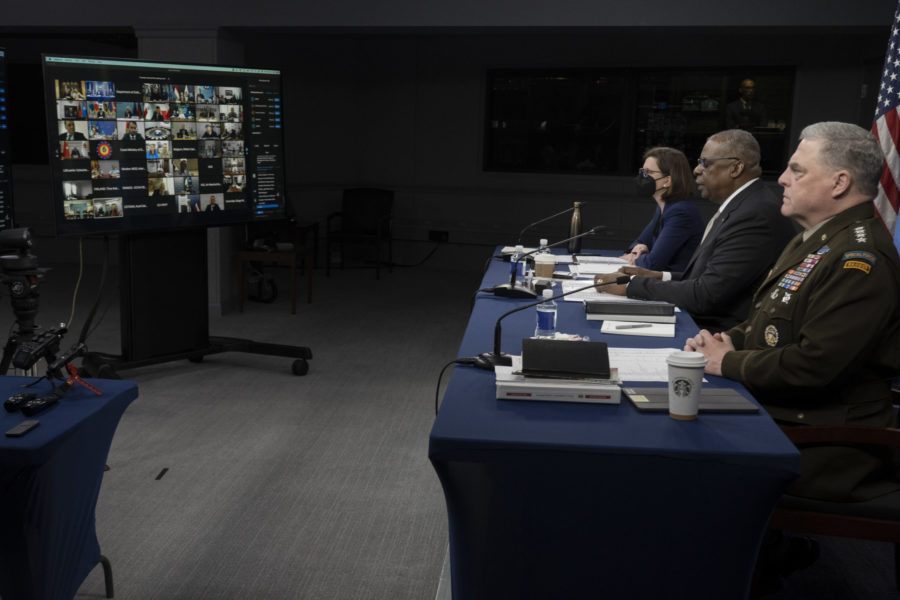Defense Secretary Lloyd J. Austin III hosted his second Ukraine Defense Contact Group meeting in a virtual format May 23, drawing 47 nations that back Ukraine’s fight against Russia but leaving questions about when the war might end.
New coastal defense systems and more artillery, armor, and tanks were highlighted among Ukraine’s needs as its major shipping port remains closed, cutting off the country economically from the world. Austin and Chairman of the Joint Chiefs of Staff Army Gen. Mark A. Milley told reporters that targeted assistance will continue but that Ukraine’s political leadership alone would decide any concessions to Russian President Vladimir Putin to end the conflict.
“In terms of what his overall strategy is, that’s unknown,” Austin said of Putin’s thinking, speaking in the Pentagon briefing room following the group meeting. “Our effort is to do everything that we can to strengthen Ukraine’s hands on the battlefield and also at the negotiation table.”
In recent days, Russia has expelled Ukrainian opposition from the Sea of Azov port city of Mariupol and has consolidated gains in the Russian-speaking east of the country. Experts believe Russia will begin a tight administration of the city, protect against a counteroffensive, and expand gains in the south of the country to cut Ukraine off from the Black Sea.
Milley said the U.S. will continue to provide arms to Ukraine for as long as directed while better managing the risk of escalation with Moscow now that a military-to-military communication channel has re-opened. Meanwhile President Joe Biden signed a $40 billion Ukraine assistance bill May 19 that will continue to flow arms until at least September.
Targeted U.S. assistance packages include long-range weapons, armor, and unmanned aerial vehicles, Austin said.
“We’ve gained a sharper and shared sense of Ukraine’s priority requirements and the situation on the battlefield,” Austin said, noting the contact group participation of Ukraine Defense Minister Oleksii Reznikov.
“In terms of what their needs are, they really are pretty much the same as they were the last time we talked,” Austin said, referring to an April 26 in-person meeting at Ramstein Air Base, Germany. “The fight is really shaped by artillery in this phase.”
Austin refused to speak to specific new systems that may be under discussion, such as the High Mobility Artillery Rocket System (HIMARS). Milley, however, said the U.S. continues training Ukrainian troops on modern weaponry in several nearby countries.
Austin also said the meeting of the contact group included new nations Austria, Bosnia-Herzegovina, Ireland, Colombia, and Kosovo, expanding the network of countries willing to provide aid to Ukraine.
New arms donations highlighted by the defense secretary included Danish Harpoon anti-ship launchers and missiles; Czech attack helicopters, tanks, and rocket systems; and more artillery from Italy, Greece, Norway, and Poland. Overall, Austin said the United Kingdom has played a “leading role” in helping to coordinate and send its arms into Ukraine.
Austin will next meet with members of the contact group on the sidelines of the NATO defense ministerial in Brussels on June 15.
U.S. Defenses in Europe
Milley highlighted the expansion of U.S. deterrence in the European theater related to the Russian invasion of Ukraine, noting that troop levels have raised by more than 30 percent in recent months from 78,000 to 102,000.
“We stand ready as part of a whole of government approach for the United States, and really a whole of alliance approach and partner effort,” he said.
Air assets include 12 fighter squadrons and two combat aviation brigades.
U.S. Air Force fighter squadrons operating in the theater include F-16 deployments to Fetesti Air Base, Romania, and F-35s deployed to Spangdahlem Air Base, Germany. The Marine Corps is operating F/A-18 at Lask Air Base, Poland, and Navy E/A-18 Growlers conduct air policing missions from Spangdahlem.
NATO Air Command confirmed to Air Force Magazine recently that further U.S. assets include RQ-4 Global Hawks, MQ-9 Reapers, U-2s, E-8C Joint Stars, and a variety of tankers operating from both Spangdahlem and RAF Mildenhall.
Milley said however that the United States was careful not to come into conflict with Russian forces, noting that there are presently no U.S. vessels in the Black Sea, which Russia has mined and conducts military operates with its Black Sea fleet.
To prevent accidental conflict and to manage escalation, Milley for the first time since before the Feb. 24 start of the conflict spoke to his Russian counterpart May 19.
“We have been able to re-open communications at the military-to-military level,” Milley said. “The Secretary has all of us in this building, throughout the military, focused on managing risk and the potential for escalation.”
Reflecting on diminishing U.S. stocks of arms due to presidential drawdown authority shipments to Ukraine, Milley described critical munitions and preferred munitions, such as small arms, tanks, Javelin missiles, man-portable air defense systems (MANPADS), smart munitions, and precision-guided missiles.
“Right now, the risk to ourselves is relatively low,” Milley said. “Our risk has been managed appropriately.”
